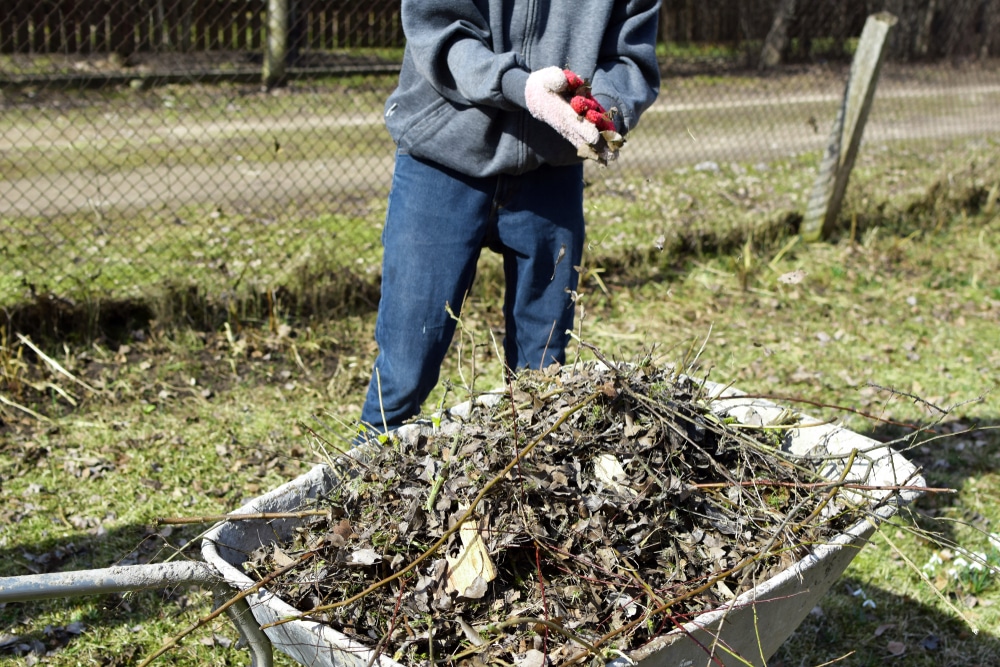Keep off the Grass: Yard Care Tips for Busy Families
A beautiful lawn can be easy to maintain and manage, until the kids take over. One of the greatest attributes of a well-sown lawn is its toughness. Lawns deal with hours of running and jumping from the kids, soccer and baseball practice and even bikes and skates taking their turn to roll over the turf.
Your lawn readily puts up with all this daily abuse so it’s no surprise that occasionally you’ll find trampled spots, brown spots and areas where a little extra TLC is needed. Some of us are happy to accept we can’t have the perfect lawn if it’s constantly the kids’ main playground, but if you want to protect your lawn and keep it in top condition, even with a family to cater for, it is certainly possible.

Getting the Kids in Line
There’s nothing better than getting the kids out from under your feet and sending them out into the yard for an hour or so. They benefit from the fresh air and a chance to let off steam and it minimizes their screen time and hours spent in front of video games. Your yard may even have play gyms, swing sets and more to ensure the kids are kept occupied when they spend some time outside, but constant use of the same areas of the yard can kill off grass and create huge bare spots. Here are some tips to help ensure your lawn isn’t full of patches, but they do require some cooperation from the kids too:
1. Communicate
Young kids may not be thinking about much more than having fun when they’re enjoying time in the yard, but you can chat about the importance of taking care of the lawn and give them designated spaces to dig and play, like sandboxes, and set other areas as off-limits. Later we’re looking at age-appropriate yard care tasks you can involve the kids in, too.
2. Rotate the Toys
Large and heavy toys and items like the kids’ pool, Slip-n-Slides and corn hole games should be moved to different locations around the lawn to minimize the risk of the grass underneath turning brown. Be sure to store them off the lawn when not in use so there’s less pressure on the grass and it has the chance to grow and breathe.
3. Child-Friendly Surfaces
If you put a swing set or other play equipment in place, then consider laying different surfacing below it. Most school and park play areas use mulched wood or soft impact tarmac as the base for their play equipment, so you could consider the same for home. This ensures your kids aren’t constantly trampling over the grass when using their jungle gym and swings. While you may not want to consider turning your yard into an adventure playground, it makes sense to set aside at least a portion of it so the kids can enjoy themselves and you can worry less about your lawn becoming a mud pit.
4. Keep them off the Ground
While you can’t completely stop the children from walking on the grass and ground, you could take the fun skywards and invest in a treehouse. Treehouses are something all kids dream of and it gives them their own special den outside, which is much more interesting than messing around on the lawn. You could build your own or invest in one ready-made from a wide range of companies out there.

Protecting your Grass and Turf
Your lawn can and should be something you are proud of, but keeping it luscious and green does involve some work, especially if there are little feet trampling over it regularly. To keep your lawn in peak condition, extra care is needed and winter is the best time to begin planning to protect your grass ready for the spring. Consider these steps to give your lawn the best chance of looking amazing by summertime:
Step One: Seed your Yard
Once you’ve identified the bare and thinning patches of your lawn, apply a generous amount of seed to bring the grass back to life. Wear and tear and excess footfall can’t be avoided, but you can work to give it the best chance of survival. Once seeded, you need to water the lawn regularly. You could also consider turf reinforcement meshes or netting to give the grass the best chance to return to its former glory.
Step Two: Lawn Aeration
The soil beneath your lawn becomes compacted over time, which in turn, leads to problems with water drainage, nutrient absorption, and air circulation. Aerating your lawn can help minimize the damage caused by compaction. Simply punch 3” deep holes into the lawn and this will help loosen up the soil and prevent the issues that come with compaction. Aerating your lawn helps your lawn to breathe, as well as making it greener and healthier. The grass has a better environment in which to grow, and you can periodically punch more holes in to ensure the soil remains in the best condition, and nutrient absorption isn’t limited.
Step Three: Reuse Grass Clippings
It’s natural to try and clear up the clippings once you’ve mown the lawn, but if you leave them where they are, they can decompose naturally and return their nutrients back into the soil. This improves the soil’s quality and reduces the need to add additional fertilizers and composts.

Step Four: Minimize Mud
Muddy patches and pools are common when the kids decide the lawn is the perfect place for penalty shoot-outs in their soccer game, or the pool just happens to get tipped over. Excess mud negatively impacts the grass growth and if you’ve just seeded it, the seeds can easily be washed away and result in a patchy lawn. Too much water can even kill the grass. Drying up a muddy lawn may require looking into your drainage or considering a French drain system.
Step Four: Deal with Weeds
Once weeds set in, they can quickly take over the whole yard. Weeds can ruin the look of your yard and they can leach all the nutrients, sunlight, water and space that your grass and other plants require. You can remove weeds at the root, or you can consider chemicals. Finding the right treatment for your yard will depend on the weeds you find and how widespread they are. Simply lopping their heads off or mowing them down is not the answer.
Step Five: Feeding your Lawn
Aerating your lawn helps its natural nutrients to flourish, but you can also feed your lawn to bring it to life and ensure it’s as green as possible. There are fertilizers designed for each season and you can explore the different options on the market. All feeds and fertilizers come with recommended application rates and you can increase the feed in areas where the grass is sparse or dried out.
Popular Grasses for American Yards
While most of us just inherit the lawn as it is and we probably don’t even know what particular grass has been sown, it is possible to choose the grasses for your lawn to suit your regional climate. The grasses found across the US are classified broadly as warm season or cool season and here’s a closer look at the differences between the two.
Warm Season Grasses
Warm season grasses are grown in June when temperatures are between 75- and 90-degrees Fahrenheit. These grasses tend to brown or go dormant once the temperatures drop below 55 degrees. With this in mind they are best suited to the warmest climates of the Deep South and the lower regions of the southwest and southeast. Warm season grasses include Centipede, Bermuda Bahia, Zoysia and St. Augustine.
Cool Season Grasses
As the name suggests, cool season grasses reach their peak during cooler times, flourishing at temperatures ranging from 65 to 80 degrees Fahrenheit. Peak growing season is the beginning of both Spring and Fall. These grasses include Kentucky Bluegrass, Tall and Fine Fescues and Ryegrass. They are particularly suited to regions with cold winters and hot summers such as New England, Northern California, the upper Midwest and the upper Great Plains. They are hardier warm season grasses and usually remain green throughout winter, unless frozen.
The right type of grass for your lawn will depend on other factors than climate, but it is worth keeping in mind if you’re looking for seed or turf to suit your yard. Hardier grasses are also worth considering if you do plan to allow the kids to enjoy the lawn as they please.

Getting Kids involved with Yard Work
If you want your kids to care about the yard, then you need to get them involved and help them feel responsible for it. You can begin this from as young as you like, with age-appropriate garden tasks possible for kids as young as three. Let’s take a look at what to consider for each age group and how to get your kids as passionate about the yard as you are:
Preschoolers
Kids aged three to four can dig to their heart’s content, under your supervision. Much of gardening is simply digging and kids love to dig. For the youngest budding gardeners, let them dig holes for planting or move mulch around so it’s evenly spread in beds and borders.
Kindergartners
Five-year-old kids are at the height of discovering their creative and imaginative side. The time you spend in the yard together can still involve digging and watering, let them explore the yard and create their own vegetable patch or snail farm.
Early Elementary Kids
Children aged up to seven can use their time in the yard to build up their academic skills. Get them to read seed packets out, make plant markers and be involved when you go to the store and purchase plants or the yard. They’ll probably be keen to explore the yard’s bug population too so let them see what they can find.
Middle Elementary Kids
Kids up to nine can take pride in their yard work and may even want to step into the design side of things. Perhaps let them design a section of the yard out on paper and work with them to create their idea in reality. Kids this age can understand and explore a plant’s growing needs, sun requirements and drainage, and factor this into their plan.
Late Elementary Kids
Your ten and eleven-year-olds are probably still interested enough in enjoying time in the yard. Gardening skills can be much more advanced now, as your kids should be able to build simple structures such as trellis for pole beans and bird and bee houses. You could even see if there are any community projects for them to get involved with.
Teens
Whether or not your teen wants to be involved in the yard will differ from family to family but if you’ve always expected yard work, they still need to do their bit, whether that’s lawn care and mowing or planting and seeding.
Peace and Harmony with Lawns and Kids
Maintaining a green and luscious lawn takes effort, especially if you regularly let the kids free in the yard and the lawn is used for sports and games. However,it is certainly possible with a little discipline and understanding, as well as dedicated spaces to play, learn and develop their yard care skills.
Inevitably, there will be dry patches and bare spaces if you regularly have play equipment out on the lawn, so taking steps to zone your yard means the kids can enjoy their time outdoors without constant yelling to get off the grass. You can’t expect them to keep it in good condition if there are no rules in place, and a regimented lawn care routine will also help to ensure your grass is as green and vibrant as can be, for as many months as possible.







